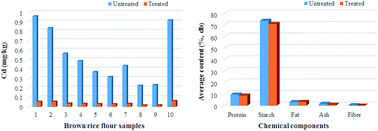A safe, efficient and simple technique for the removal of cadmium from brown rice flour with citric acid and analyzed by inductively coupled plasma mass spectrometry
Abstract
Rice (Oryza sativa L.), an important cereal crop, has been seriously contaminated by cadmium (Cd) in the world. In this study, we compared the effects of three organic acids (citric acid, malic acid and tartaric acid) which are all approved food additives on the removal of Cd and developed a safe, efficient and simple technique to remove Cd from contaminated brown rice flour using citric acid (CA). The optimal conditions for citric acid removal of Cd were determined by a three-level Box–Behnken design with three factors (CA concentration, treatment temperature and treatment time) under the condition that the liquid–solid ratio was 12 mL g−1 and the shaking speed was 150 rpm, and the results were as follows: CA concentration, 0.08 mol L−1; treatment temperature, 45 °C; and treatment time, 53.09 min. Under these conditions, the removal efficiency of Cd was 94.28 ± 0.06%, which agreed well with the predicted value of 94.75%. Moreover, the contents of the main chemical components such as protein, starch and fat in the brown rice flour were still very high after citric acid treatment, indicating that this technique did not affect the quality of brown rice flour. This technique was also used in other brown rice flour samples and satisfactory results were obtained. Therefore, this technique is efficient in removing Cd and may have the potential to be used in the food industry to solve the Cd-rich rice problem in the world.


 Please wait while we load your content...
Please wait while we load your content...